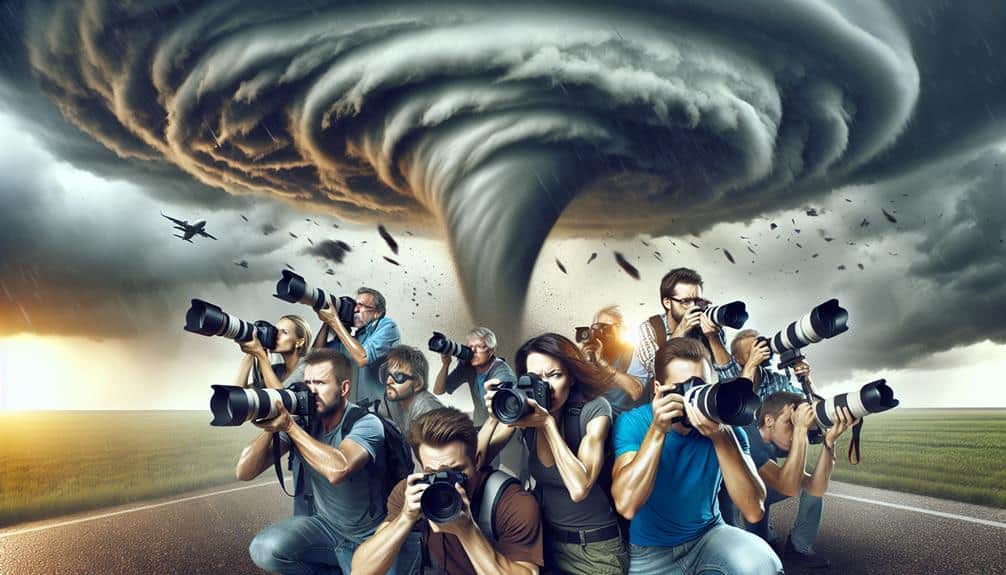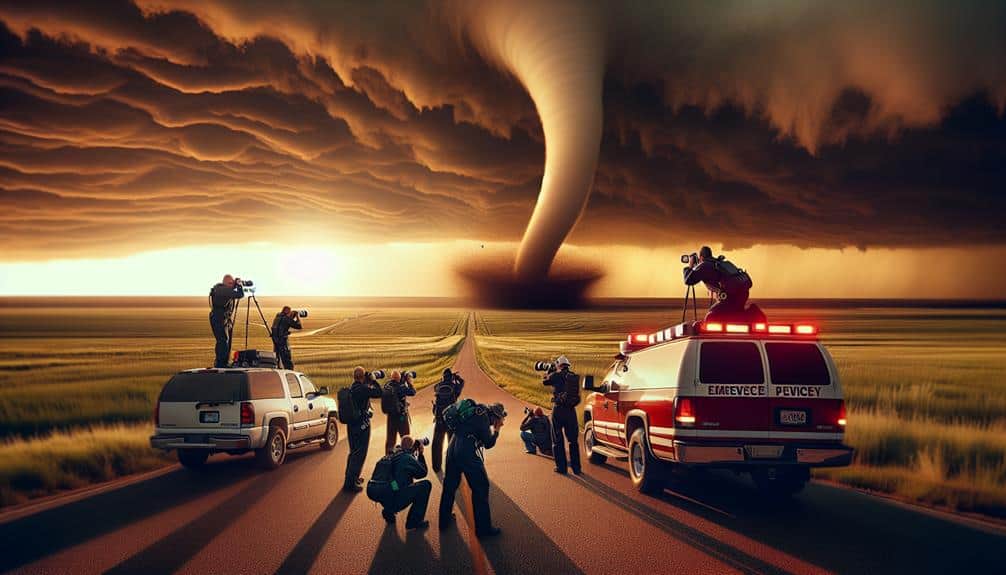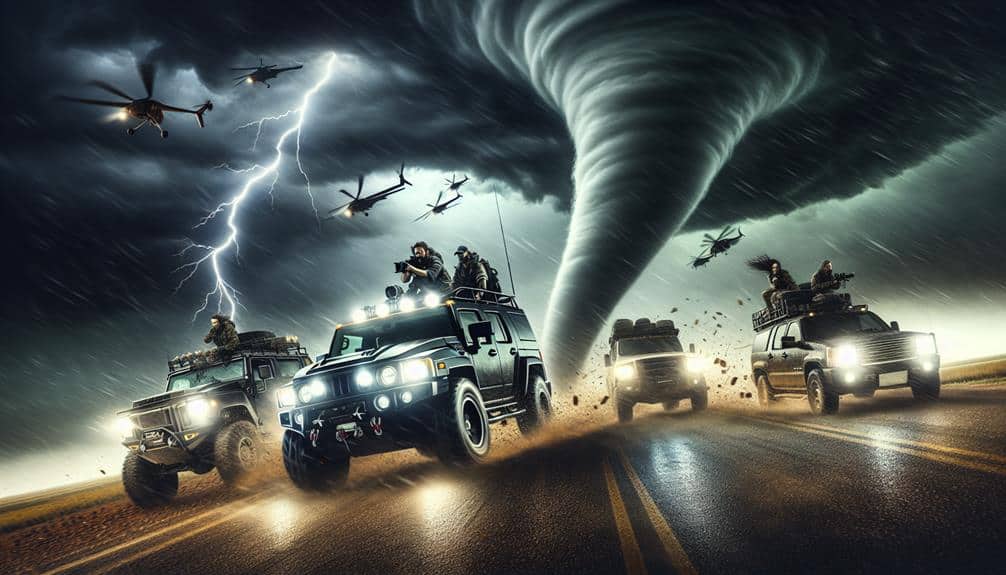In storm chasing, we prioritize seven key strategies to enhance emergency response. We use real-time communication systems for timely coordination with local authorities. Our rigorous safety protocols and training guarantee team readiness. Advanced weather forecasting with high-resolution data helps predict storm paths accurately. Essential emergency kits, meticulously prepared, boost operational safety. Coordinating efforts with local authorities streamlines responses. We employ sophisticated data collection and sharing methods for precise meteorological analysis. Post-storm analysis leverages drones and satellite imaging to assess damage efficiently. For a deeper understanding of these strategies' implementation and impact, exploring further will be advantageous.
Key Points
- Utilize real-time communication systems to ensure prompt responses and effective coordination with local authorities.
- Adhere to rigorous safety protocols and engage in continuous, hands-on training programs.
- Integrate multiple data sources and advanced algorithms for precise weather forecasting and storm path prediction.
- Maintain a well-prepared emergency kit with essential supplies like first aid, food, water purification, and portable weather radio.
Real-time Communication Systems
Real-time communication systems are crucial for storm chasers to coordinate effectively and respond promptly to emergencies. We rely on advanced technologies that facilitate remote monitoring and provide instant alerts to ensure timely updates on storm developments and potential hazards.
These systems integrate data from multiple sources, including radar, satellite imagery, and ground-based sensors, allowing us to track storm movements and intensity with precision. The use of remote monitoring tools means we can observe weather patterns from various locations, providing a thorough view of storm dynamics.
This capability is vital in making informed decisions on whether to reposition or take shelter. Instant alerts, often delivered through mobile apps and specialized communication networks, enable us to receive real-time notifications about sudden changes in weather conditions, such as tornado formation or flash flooding.
Safety Protocols and Training
To complement our real-time communication systems, we rigorously adhere to safety protocols and undergo extensive training to mitigate risks and enhance our emergency response capabilities. Our safety drills are meticulously designed to simulate various storm scenarios, ensuring that each team member can efficiently and confidently execute their roles under pressure. By conducting regular drills, we reinforce standard operating procedures and identify potential areas for improvement.
Our specialized training programs are tailored to the unique demands of storm chasing. These programs include modules on vehicle safety, first aid, and the proper use of emergency equipment. We emphasize hands-on learning, allowing us to practice deploying storm shelters, maneuvering hazardous terrain, and maintaining situational awareness.
Evidence-based approaches guide our training, rooted in the latest research on storm dynamics and emergency management. We continuously update our protocols based on post-mission analyses and emerging best practices in the field.
Advanced Weather Forecasting
Leveraging state-of-the-art meteorological technology, we integrate multiple data sources to enhance the accuracy and timeliness of our weather forecasts. By utilizing high-resolution satellite imagery, we can identify cloud formations and weather patterns in real-time, providing us with vital information on storm development.
These satellite images, when combined with radar analysis, offer a complete view of atmospheric conditions. Radar analysis allows us to measure precipitation intensity, track storm movement, and estimate wind speed and direction, all of which are essential for making informed decisions.
Our approach is evidence-based, relying on data from various meteorological instruments and models. We use advanced algorithms to assimilate data from ground stations, Doppler radar, and polar-orbiting satellites. This integration enables us to generate highly accurate forecasts that are essential for effective storm chasing.
By analyzing this data, we can predict storm paths with greater precision, allowing for timely and strategic responses.
For those who value freedom and the excitement of storm chasing, this technological edge provides the confidence needed to navigate severe weather safely. Our advanced forecasting methods not only enhance our operational efficiency but also guarantee that we can make proactive decisions, minimizing risks and maximizing our effectiveness in the field.
Emergency Kit Essentials
While our advanced forecasting methods provide important insights, having a well-prepared emergency kit is equally vital for guaranteeing safety during storm chasing missions. We need a detailed emergency kit that addresses a variety of potential scenarios.
Essential emergency kit contents include first aid supplies, non-perishable food, water purification tablets, and a portable weather radio. Additionally, we should include extra batteries, flashlights, a multi-tool, and thermal blankets. These items are essential for maintaining operational readiness and personal safety.
Preparedness training is another important aspect of our strategy. It's not enough to have the right tools; we must also know how to use them effectively. Regular training sessions should cover first aid procedures, radio communication protocols, and emergency shelter setups. By continuously honing these skills, we enhance our ability to respond swiftly and efficiently in crisis situations.
Moreover, a well-stocked emergency kit and rigorous preparedness training contribute to our autonomy and resilience in the field. This approach guarantees we can navigate unpredictable storm environments with confidence. As storm chasers, our freedom to operate safely and effectively hinges on meticulous planning and preparation.
Let's prioritize these elements to maximize our mission success and personal safety.
Coordination With Local Authorities
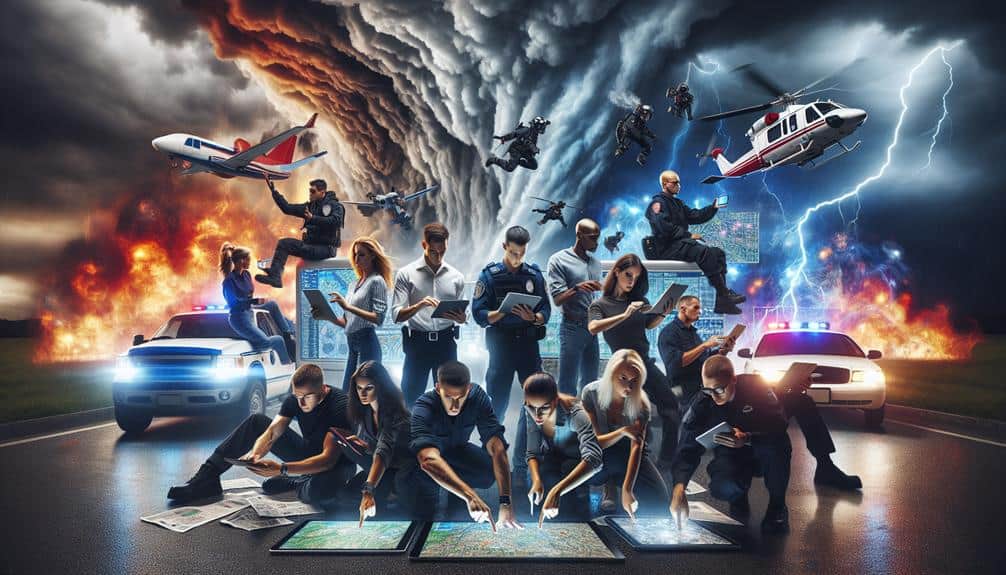
To enhance our storm chasing operations, we must establish robust communication channels with local authorities. Sharing real-time data can greatly improve situational awareness and response times.
Establish Communication Channels
Effective storm chaser emergency response relies on establishing robust communication channels with local authorities to guarantee coordinated efforts and timely information exchange. We must prioritize setting up clear communication protocols and maintaining an updated list of emergency contacts. These protocols should detail the methods, frequency, and content of communications during a storm event. An evidence-based approach guarantees that we aren't just prepared, but also adaptable to the dynamic nature of severe weather.
Network coverage can be unreliable during storms, making satellite phones a vital backup. Satellite technology provides a reliable alternative when terrestrial networks fail, securing we maintain a continuous line of communication with local authorities. Our analytical perspective highlights the importance of redundancy; relying solely on one form of communication can be a significant risk.
Additionally, integrating multiple layers of communication—such as radios, mobile networks, and satellite phones—enhances our ability to relay information swiftly and accurately. We must also regularly test and update these systems, securing that all devices are operational when needed most.
Leveraging our established communication channels, we can now focus on sharing real-time data with local authorities to guarantee synchronized responses to evolving storm conditions. By utilizing advanced data sharing platforms, we assure that critical information flows seamlessly, augmenting our emergency response capabilities.
Real-time data, including storm trajectories and intensities, directly informs decision-making processes, enabling local authorities to implement timely and effective measures.
Through technology integration, we can enhance the precision of our storm tracking and reporting. High-resolution radar data and satellite imagery can be instantly shared with emergency management teams, facilitating immediate situational awareness. This rapid data dissemination is pivotal in mobilizing resources where they're needed most, reducing response times, and ultimately saving lives.
Community engagement also plays a key role in our data-sharing strategy. By incorporating feedback from local residents and integrating crowd-sourced data, we can refine our models and improve the accuracy of our forecasts. This participatory approach not only empowers communities but also strengthens the overall resilience of our emergency response infrastructure.
Develop Joint Protocols
We'll establish joint protocols with local authorities to guarantee a cohesive and efficient emergency response during storm events. By developing collaborative partnerships, we can synchronize our efforts, making sure that information flows seamlessly between storm chasers and emergency responders. This alignment not only enhances operational efficiency but also optimizes resource allocation, which is critical in high-stakes situations.
To achieve this, we'll implement standardized procedures that detail specific actions for various storm scenarios. These procedures will encompass communication protocols, data-sharing mechanisms, and predefined roles for all involved parties. Evidence suggests that such standardized approaches minimize confusion and expedite decision-making processes.
For instance, incorporating real-time updates into a unified communication system allows for rapid dissemination of critical information, thereby improving situational awareness for all stakeholders.
Moreover, these joint protocols will be regularly reviewed and updated based on field experiences and technological advancements. Continuous improvement ensures that our strategies remain relevant and effective.
Data Collection and Sharing
Accurate data collection and timely sharing are crucial for enhancing storm chaser emergency response efforts.
To begin with, data visualization techniques are essential in transforming raw meteorological data into understandable formats. We can utilize heat maps, storm tracking models, and real-time dashboards to visualize storm patterns effectively. These visual tools not only improve our situational awareness but also facilitate quicker decision-making processes.
Information sharing platforms are equally important. By leveraging cloud-based systems and secure communication networks, we guarantee that essential data reaches all stakeholders promptly. Platforms like these allow for seamless integration of various data sources, enhancing the reliability of the information transmitted.
Collaborative research is another cornerstone. Engaging in joint studies with meteorological institutions and universities enables us to refine our data collection methods and develop innovative data analysis strategies. Through these partnerships, we can implement machine learning algorithms to predict storm trajectories more precisely, thereby optimizing our response plans.
In essence, refining our data collection and sharing protocols empowers us to react swiftly and efficiently. By adopting advanced data visualization techniques and robust information sharing platforms, and engaging in collaborative research, we can significantly strengthen our emergency response capabilities in the face of severe weather events.
Post-Storm Analysis
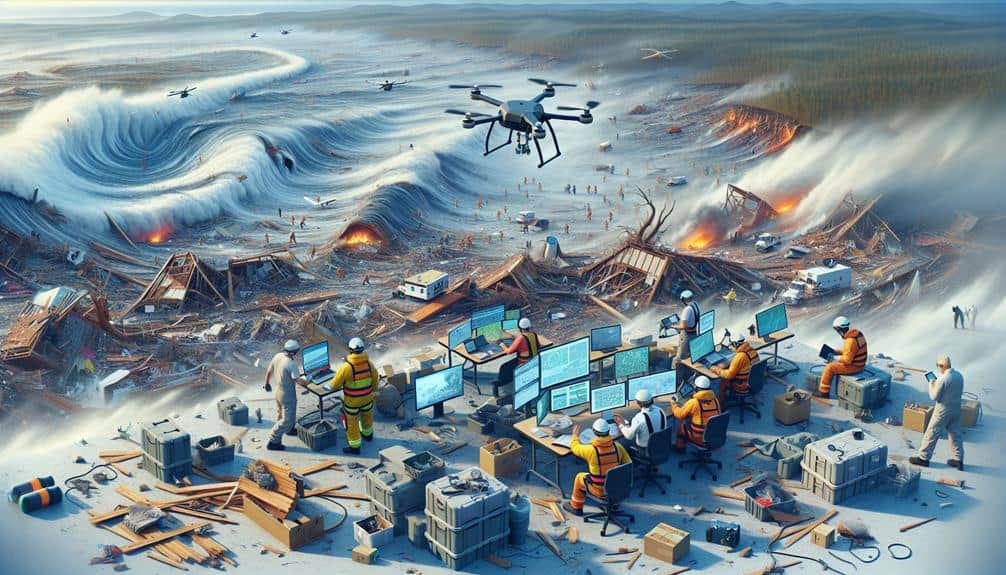
In our post-storm analysis, we'll evaluate the effectiveness of our data collection methods and assess the damage using advanced techniques.
By analyzing the accuracy and timeliness of the data captured, we can identify areas for improvement.
Additionally, we'll employ evidence-based damage assessment models to quantify the storm's impact accurately.
Data Collection Methods
Collecting high-resolution data after a storm is crucial for understanding its impact and improving future emergency response strategies. We leverage advanced technologies such as drones and satellite imaging to capture detailed post-storm landscapes.
Using drones, we can obtain high-resolution aerial photographs and videos, allowing us to meticulously analyze structural damages and flood extents. Drones offer flexibility and precision, enabling us to access hard-to-reach areas and collect data without putting personnel at risk.
Satellite imaging complements drone data by providing a broader perspective of the affected region. Satellites equipped with advanced sensors capture real-time imagery, which we can analyze to identify large-scale effects such as changes in land cover, water bodies, and infrastructure. By integrating drone and satellite data, we create detailed maps and models that highlight the severity and distribution of storm impacts.
Our approach is both analytical and evidence-based, ensuring that our data collection methods are robust and reliable. This integration of technology not only enhances our immediate response but also contributes to long-term resilience planning.
Damage Assessment Techniques
Once the storm passes, we employ a range of advanced damage assessment techniques to thoroughly evaluate the affected areas. Our primary tools include drone surveillance and GIS mapping, both of which provide precise and detailed data.
Drone surveillance offers an unparalleled vantage point, allowing us to capture high-resolution images and videos of the impacted regions. These aerial views enable us to identify structural damages, flooded zones, and obstructed routes without putting ourselves in harm's way. The real-time data collected by drones is invaluable for making immediate decisions and coordinating emergency responses efficiently.
In conjunction with drone data, we utilize GIS mapping to compile and analyze geographical information. GIS mapping helps us visualize the extent of the damage spatially, providing a detailed understanding of the storm's impact on infrastructure, natural landscapes, and population density. By layering different data sets, we can identify patterns and prioritize areas that require urgent attention. This analytical approach ensures that our response is both focused and efficient.
Combining drone surveillance and GIS mapping, we create a robust framework for post-storm analysis. These techniques allow us to act swiftly and decisively, guaranteeing that affected communities receive the support they need to rebuild and recover.
Frequently Asked Questions
How Can Storm Chasers Minimize Their Environmental Impact?
We can minimize our environmental impact by adopting eco-friendly practices and engaging in conservation efforts. Utilizing low-emission vehicles and reducing non-essential travel are evidence-based strategies that support our freedom while protecting natural habitats.
What Are the Personal Qualifications to Become a Storm Chaser?
To become storm chasers, we've got to make sure we have experience in meteorology and relevant education. Analytical skills and field training are essential. Our qualifications must balance theoretical knowledge and practical application to navigate storms effectively.
How Do Storm Chasers Mentally Prepare for Extreme Weather Events?
We mentally prepare for extreme weather events by building mental resilience and preparedness through stress management techniques and coping mechanisms. Evidence shows that these strategies help us stay focused and effective, ensuring our freedom to chase safely.
What Are the Ethical Considerations for Storm Chasers?
Like a double-edged sword, our storm chasing raises ethical dilemmas. We must balance public safety and scientific curiosity. We need to guarantee our actions don't endanger others, while responsibly sharing data to improve emergency responses.
How Do Storm Chasers Fund Their Expeditions?
We secure funding sources through sponsorships, financial planning, and strategic investments. Sponsorships from weather-related companies and media outlets play an important role, while careful financial planning guarantees our resources are effectively allocated for successful expeditions.
